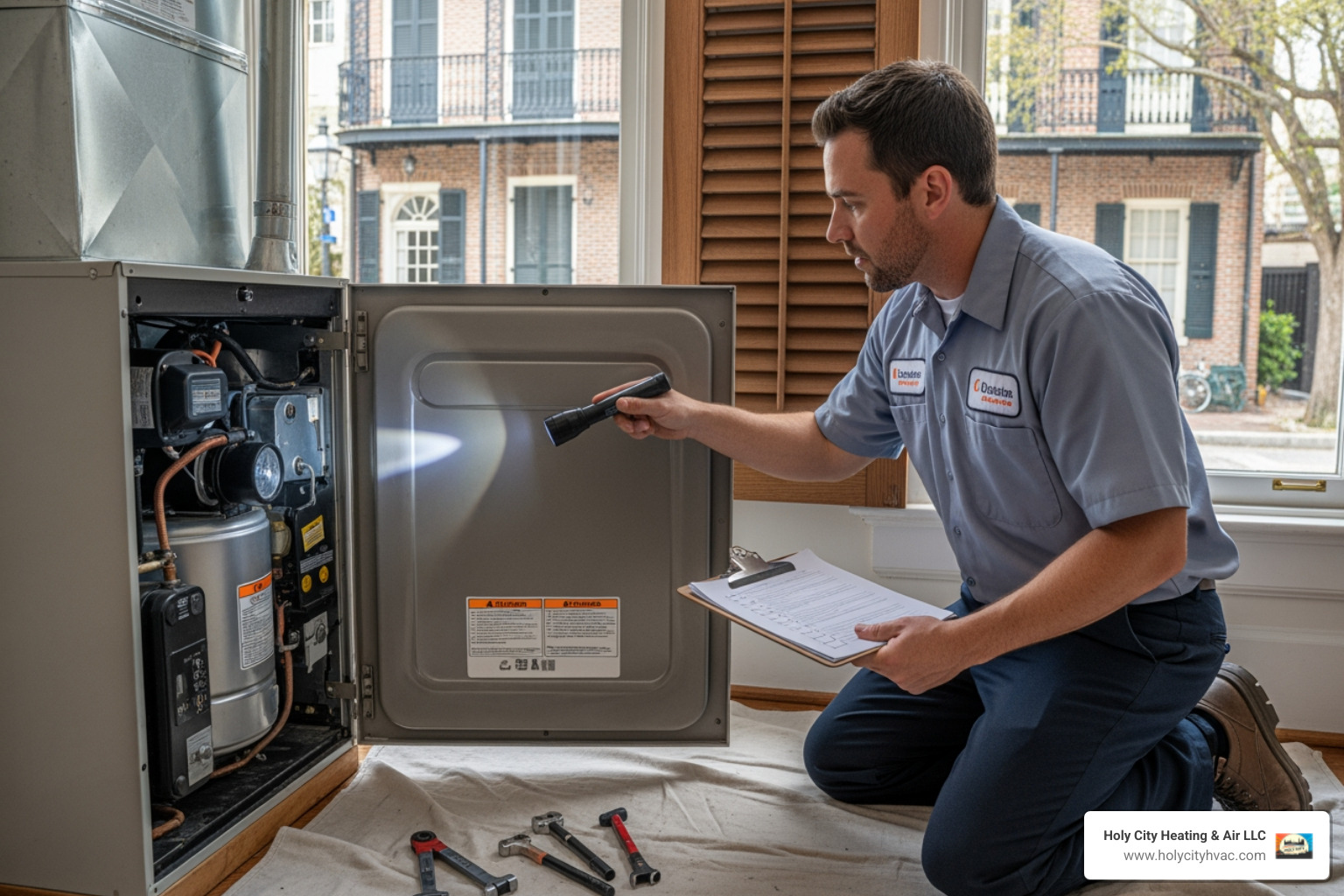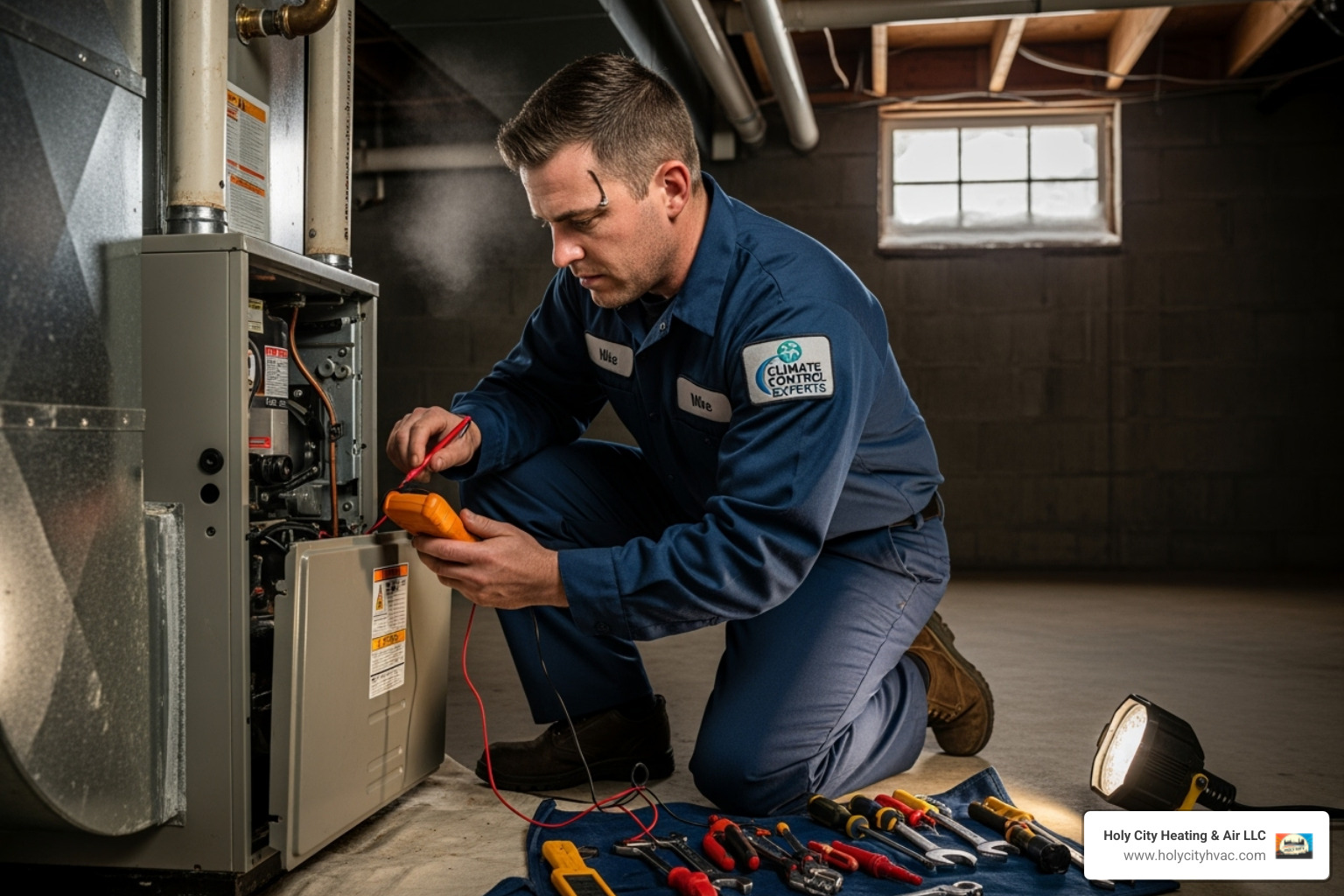
Why Understanding Emergency Furnace Repair Matters
When your furnace breaks down in the middle of a cold night, you need fast, reliable help. Waking up to a freezing house is stressful enough without wondering what comes next.
Several factors influence how your emergency visit is handled and how quickly heat is restored, including:
- Timing of the breakdown (after-hours or holidays can affect response options and scheduling)
- Part complexity, from simple fixes to major component replacements
- System age, as older furnaces may need harder-to-find parts
- Geographic and home-specific conditions (access, ventilation, and local requirements)
Emergency furnace repairs are all about speed, safety, and restoring comfort. The “emergency” part means you need immediate assistance when demand is high and availability may be limited.
However, the specific problem with your furnace matters just as much as when you need it fixed. A simple ignitor issue is very different from a major component failure, such as a heat exchanger problem.
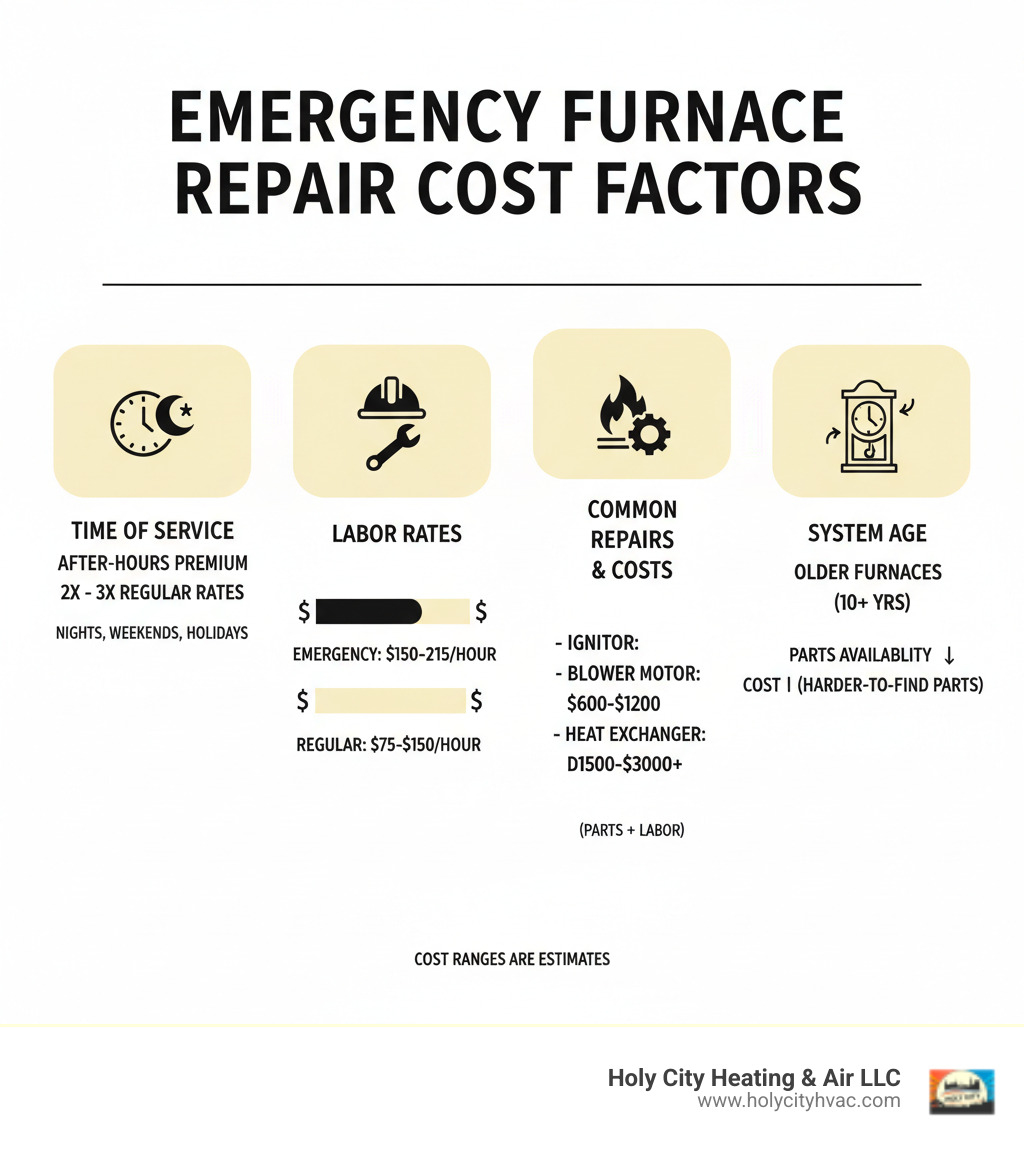
Key Factors That Shape Emergency Furnace Service in Charleston
Picture this: it's 2 AM on a Saturday night in January, and your furnace just gave up. In these moments, what matters most is a fast, safe return to comfort.
Emergency service is about logistics, availability, and the complexity of the repair. Understanding these drivers helps you make quick, confident decisions during a heating crisis. For comprehensive heating solutions in the Charleston area, our Heating Repair Services team is here to restore your comfort quickly.
After-Hours and Weekend Response
When your furnace stops working at an inconvenient time, you’re asking a technician to arrive outside of normal business hours. These calls prioritize safety and comfort, focusing on immediate response, clear communication, and practical next steps tailored to your home and family.
Location and Accessibility
Charleston-area homes vary—from tight crawlspaces to attic installations—and that can affect how your system is accessed and serviced. Urban versus rural locations may also influence scheduling and parts availability. A straightforward location helps speed up diagnostics and repairs. Our Furnace Repair Services team has experience with all types of systems and home layouts.
Furnace Age, Type, and Warranty Status
Your furnace’s age, type, and warranty status influence the approach to service. Older units can require specialty parts or alternatives if components are obsolete. Gas, electric, and oil furnaces each have unique safety checks and procedures.
Active manufacturer warranties may cover certain components, but skipping regular maintenance can void coverage. Routine service helps prevent emergencies and keeps your system in good standing, as explained in how Furnace Repair Ensures Longevity.
Common Problems: From Minor Fixes to Major Overhauls
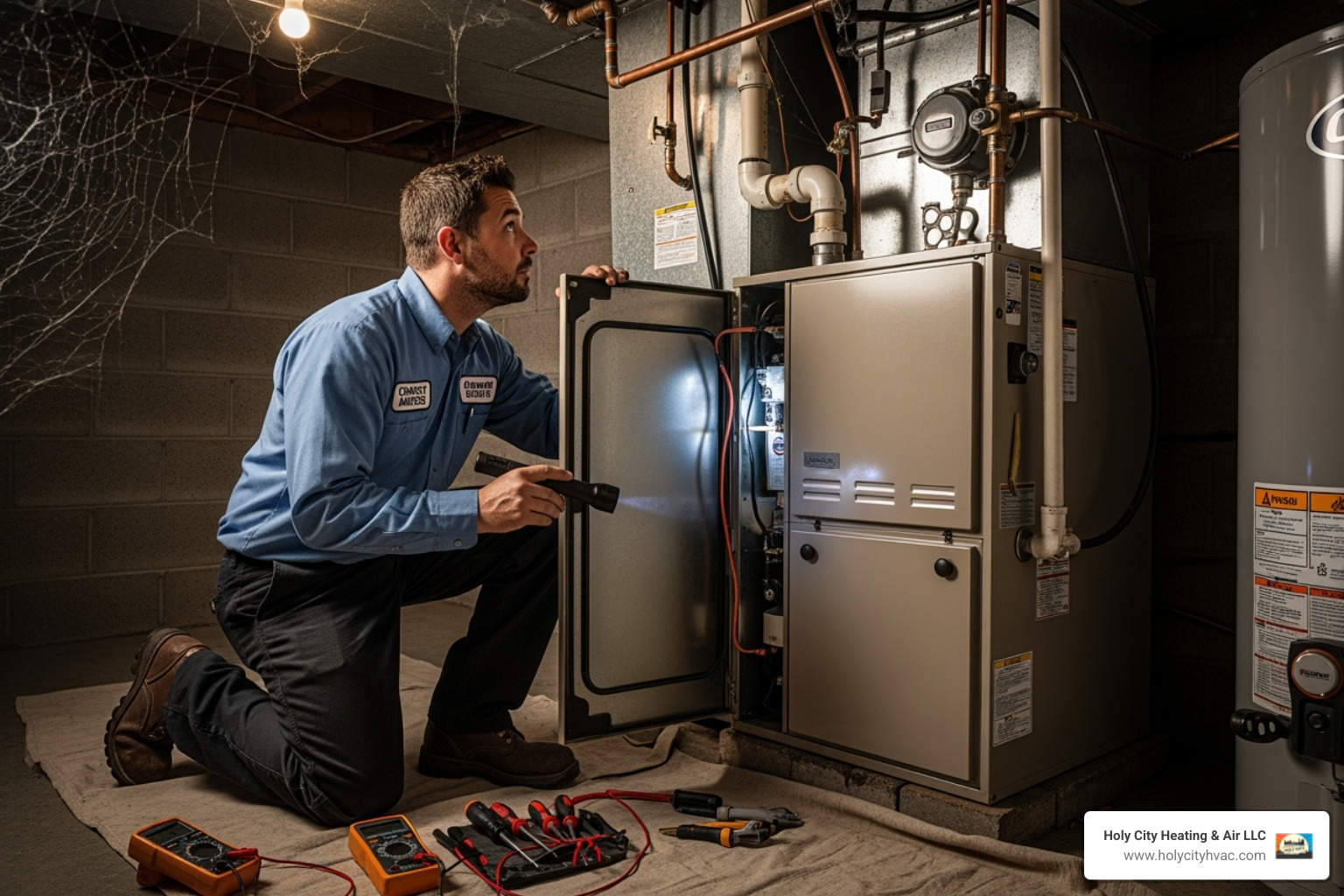
When your furnace stops working, the specific problem determines the scope and urgency of the service. Some issues are quick fixes, while others are more complex and require specialized parts and time.
Our experienced professionals focus on identifying the root cause efficiently to recommend the right solution. You can learn more about the issues we commonly encounter here: Common Furnace Repair Issues.
Inexpensive but Crucial Fixes
Some emergency calls lead to relatively straightforward repairs, even though they leave you without heat. These problems involve smaller components that are critical for operation.
- Ignitor replacement is a common failure. When the ignitor burns out, your furnace won't light.
- Flame sensor issues can also shut down your system. This safety device detects a flame, and when it's dirty or fails, the furnace shuts off as a precaution.
- Thermostat problems can cause a range of symptoms, from no heat to inconsistent temperatures. The issue could be faulty wiring or require a thermostat replacement.
- Limit switch failures are another safety-related shutdown. This component prevents overheating, and its failure can cause the furnace to cycle erratically or not run at all.
While these repairs are less complex, they become urgent when your heat stops working on a cold night. Our team is prepared to handle these common issues promptly. Heating Repair Tips for Common Issues.
Moderate to Major Repairs
Other furnace problems involve significant components that require more diagnostic time and specialized expertise. According to the U.S. Department of Energy, understanding these major components helps homeowners make informed decisions about repairs versus replacement.
- Blower motor replacement is needed when the fan that circulates heated air fails.
- Draft inducer motor problems are a safety concern, as this motor expels dangerous combustion gases. Its failure will prevent the furnace from starting.
- Control board failure is like a computer crash for your furnace, causing intermittent or complete system failure.
- Gas valve replacement involves a critical safety component that controls the flow of fuel. Due to safety implications, these repairs require licensed professionals.
These more involved repairs represent a significant portion of emergency service calls.
Analyzing the urgency and impact of major component repairs
Understanding which repairs demand immediate attention is key. Some components affect comfort, while others impact safety.
| Component | Urgency | Impact |
|---|---|---|
| Blower Motor | High - No heat distribution | Complete loss of heated air circulation; furnace runs but house stays cold |
| Control Board | High - System malfunction | Unpredictable operation; potential for further damage if ignored |
| Heat Exchanger | Critical - Safety hazard | Cracked heat exchangers can leak carbon monoxide; immediate shutdown required |
Heat exchanger cracks are the most serious furnace problem. This component separates combustion gases from your breathable air. A crack can allow carbon monoxide to enter your home, making it a true emergency that requires immediate system shutdown.
Evaporator coil leaks in heat pump systems can also cause significant heating issues and require certified technicians for repair. When facing major component failures, time is critical for comfort and safety. Our team understands this urgency. Winter Emergency Furnace Repair.
Introduction
- Already provided.
Key Factors That Drive Emergency Furnace Service
When your furnace takes an unexpected break, the impact on your home comfort can feel as chilly as your living room. An emergency visit isn’t just about the broken part—it’s shaped by timing, location, and the complexity of the issue.
When your furnace breaks down at 2 AM on a Sunday, you’re asking for immediate help when availability is limited. Our goal is to restore your comfort swiftly while being transparent about what to expect. For comprehensive heating repair services in the Charleston area, see our Heating Repair Services.
After-Hours and Weekend Response
If your furnace stops working on a holiday or weekend, emergency service prioritizes safety and timely support. These calls focus on rapid assessment, clear next steps, and getting heat back on as quickly as possible.
Labor, Location, and Accessibility
Labor is a significant part of any furnace repair, and emergencies require focused, efficient diagnostics. Here in the Charleston area, including Mt Pleasant and Summerville, service availability can vary by location. A furnace in a cramped attic or tight crawlspace may take longer to access and service, which can affect timelines. When you need swift furnace repair, we're committed to providing exceptional service: Furnace Repair Services.
Furnace Age, Type, and Warranty Status
Your furnace’s characteristics influence how service proceeds.
- Older furnaces, particularly those over 15 years old, may require parts that are difficult to source or that have approved substitutes.
- Electric systems often have different service steps than gas, propane, or oil systems, which include additional safety checks.
- A valid manufacturer parts warranty can help determine the path forward, but neglecting regular maintenance can void coverage. Regular maintenance is your best defense against emergencies: Furnace Repair Ensures Longevity.
Common Problems: From Minor Fixes to Major Overhauls
When your furnace takes an unscheduled break, the specific problem determines the scope and urgency of the visit. Some issues are quick component swaps, while others require more extensive diagnostics and repair.
Our experienced technicians start every call with a thorough diagnostic process to identify the root cause before recommending the solution. Many furnace emergencies stem from common problems that can be addressed efficiently, while some failures require more extensive repairs. Understanding these scenarios helps you prepare. Common Furnace Repair Issues covers many of these situations in detail.
Inexpensive but Crucial Fixes
Not every emergency call results in a major repair. Some of the most critical furnace components are among the more straightforward to repair or replace.
- Ignitor replacement is a top reason for emergency calls. This component lights your furnace, and when it fails, you have no heat.
- Flame sensor cleaning or replacement is another frequent issue. This safety device shuts the furnace down if it can't detect a flame.
- Thermostat issues can mimic major furnace problems but are often simpler fixes related to wiring, calibration, or unit replacement.
- Limit switch replacement is a critical safety repair. This part prevents overheating, and its failure can cause the system to stop working.
Heating Repair Tips for Common Issues provides helpful guidance on recognizing these problems early.
Moderate to Major Repairs
When an emergency involves larger components, you’re looking at more involved service due to specialized parts and additional diagnostic steps.
- Blower motor replacement may be required when the fan that moves heated air fails.
- The draft inducer motor is a critical safety part that expels combustion gases.
- Control board failure can cause intermittent or random issues.
- Gas valve service involves a critical safety component that controls fuel flow and requires licensed professionals.
Analyzing the urgency and impact of major component repairs
Some furnace problems demand immediate attention for safety, not just comfort. Understanding the urgency helps you make informed decisions.
| Component | Urgency | Impact |
|---|---|---|
| Blower Motor | High - No heat circulation | Essential for comfort |
| Control Board | High - System may not operate | Affects all functions |
| Heat Exchanger | Critical - Safety hazard | Potential safety risk |
Heat exchanger cracks represent the most serious furnace emergency. This component separates combustion gases from your home's air. When it cracks, carbon monoxide can leak into your living space. This issue often signals the need for a complete system replacement.
Evaporator coil leaks in heat pump systems are another major concern, affecting the system's ability to transfer heat and requiring specialized refrigerant handling expertise. The reality of major component failures is that they often occur at the worst possible times. Winter Emergency Furnace Repair explores these critical situations in greater depth.
Repair or Replace? Making the Smart Choice in an Emergency
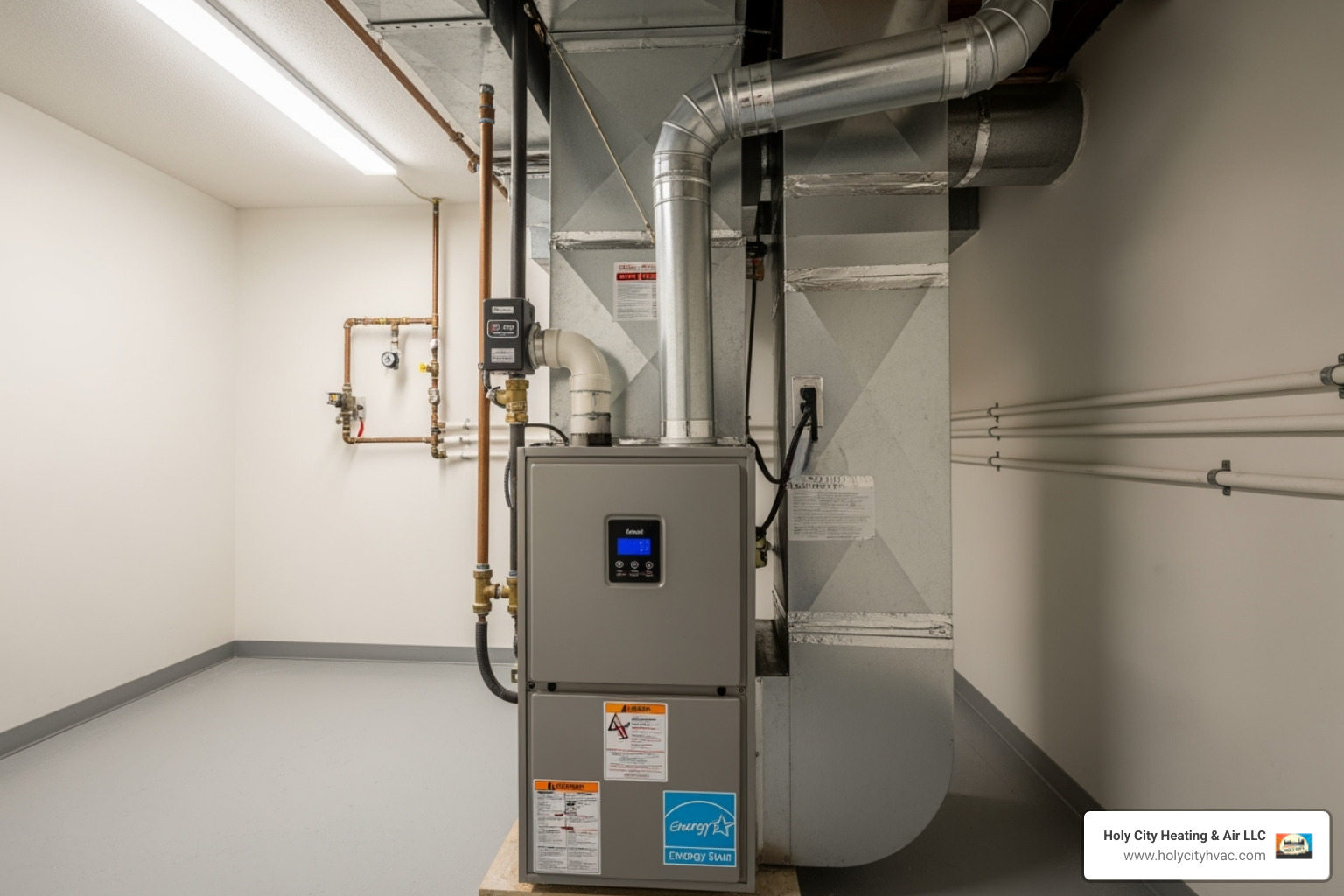
When you're facing an emergency furnace decision, you may have to choose between repairing your current system or replacing it. Sometimes, a breakdown is a sign that it's time to invest in a new, reliable system.
Long-term considerations matter. A new, high-efficiency furnace can reduce energy use, provide consistent comfort, and offer peace of mind with strong warranties. Professional installation is crucial: Why a Professional Should Install Your Furnace.
A Guideline for Your Decision
Consider your system’s age, overall condition, and the frequency of recent breakdowns. Furnaces approaching the end of their typical 15–20 year lifespan, especially those with recurring issues, may be better candidates for replacement.
Frequent emergencies are a red flag. If this is the latest in a series of problems, a new system can help you avoid further disruptions and restore confidence in your home’s comfort.
How Regular Maintenance Impacts Repair Needs and System Lifespan
Most emergency furnace breakdowns are preventable. Regular maintenance is your best defense against middle-of-the-night heating disruptions.
- Preventative tune-ups catch small problems before they become big emergencies.
- Catching minor issues early prevents a cascade effect that leads to major failures.
- Well-maintained furnaces operate efficiently for their full expected lifespan and beyond.
Most importantly, regular maintenance helps you avoid surprise breakdowns at the worst possible times. Getting your system ready before the heating season is one of the best steps you can take: Prep Your Furnace for Winter.
Navigating Your Furnace Emergency: FAQs and Pro Tips
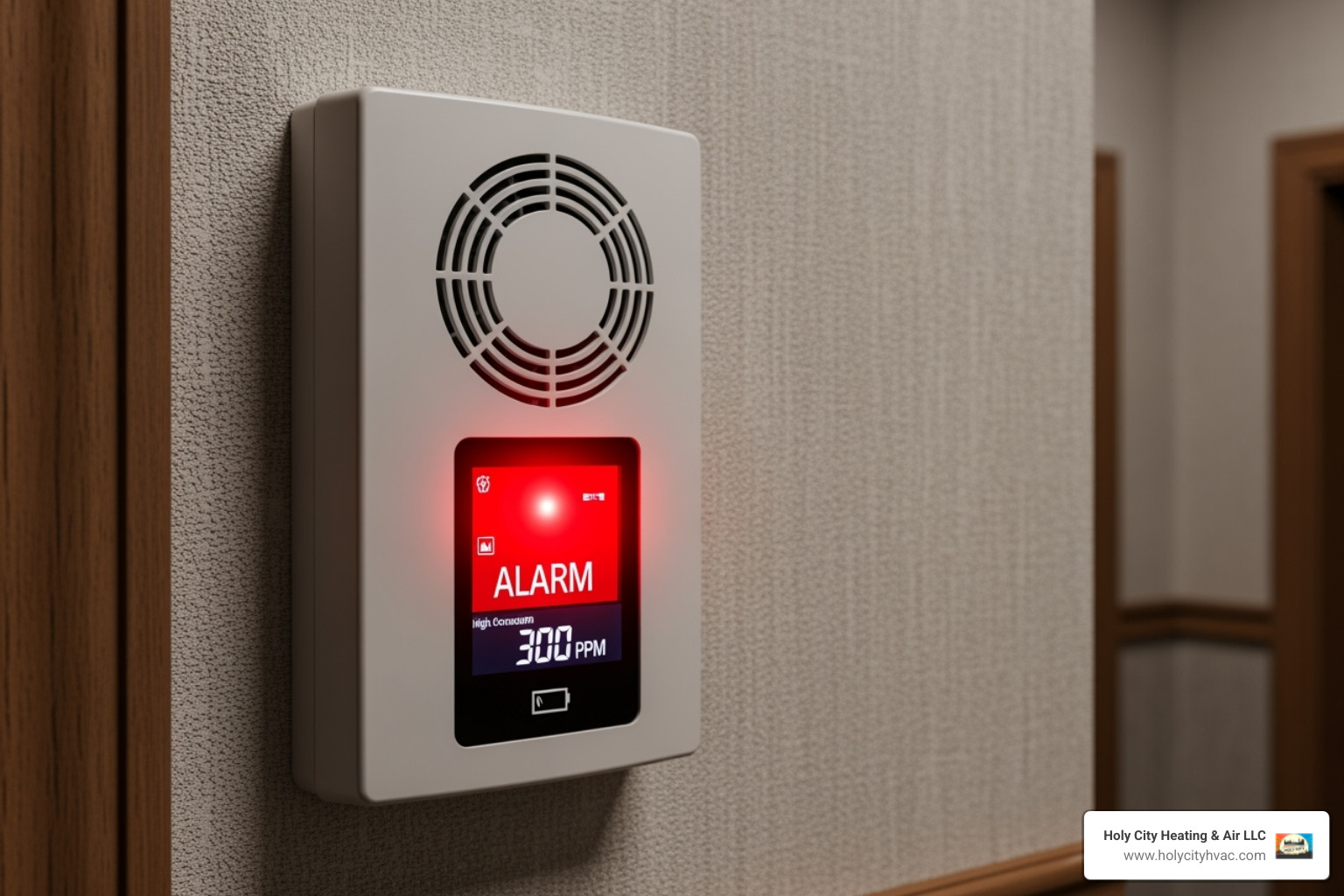
When your furnace fails, knowing how to respond can make a huge difference. Being prepared for furnace emergencies helps protect your family's safety.
Understanding when you truly need emergency service versus when you can wait until regular business hours can help you plan effectively. Recognizing genuine safety hazards is the top priority. Heating Repair Essentials provides additional guidance for winter heating situations.
What are the key signs my furnace needs an emergency repair?
Some furnace problems demand immediate professional attention. No heat production during freezing weather is an obvious emergency, especially with vulnerable family members at home.
- Strange noises like banging or grinding can signal serious mechanical failures that shouldn't be ignored.
- Gas or burning smells always warrant an emergency call. A gas odor could indicate a dangerous leak, while burning smells may point to electrical problems.
- A yellow pilot light (instead of blue) suggests incomplete combustion, which can produce carbon monoxide.
- If your CO detector sounds an alarm, evacuate your home immediately, call for emergency help, and wait for professionals to clear the area.
Other indicators include the furnace blowing cold air or cycling on and off frequently. These 5 Sounds Your Heater Shouldn't Make can help you identify when to call for help right away.
What are the risks of attempting a DIY furnace repair?
While the DIY spirit is admirable, furnace repairs present serious safety hazards that make professional service essential.
- Carbon monoxide exposure is a primary danger. This colorless, odorless gas can be deadly, and improper repairs increase the risk of leaks.
- Electrical shock is another significant threat from high-voltage connections.
- Fire risks are high with gas furnace repairs, as a small mistake can lead to gas leaks or explosions.
Beyond safety, DIY attempts often void manufacturer warranties, and misdiagnosis can lead to replacing the wrong parts. Amateur repairs can also cause additional damage, turning a simple fix into a complex problem. Furnace Repair Mistakes to Avoid details common pitfalls.
What is the difference in emergency furnace repair needs for commercial vs. residential systems?
Commercial furnace emergencies are typically more complex than residential situations. Commercial systems feature larger, more sophisticated equipment requiring specialized knowledge.
Regulatory compliance adds another layer, as business heating systems must meet stricter safety and performance standards. Business downtime considerations also make commercial emergencies particularly urgent, as a failure can mean lost revenue and safety concerns.
Specialized labor requirements for commercial systems mean technicians need specific experience. Finally, liability and insurance considerations make professional emergency service essential for businesses. Furnace Repair Needs Immediate Attention explores when heating problems require professional intervention.
Conclusion
Understanding what shapes an emergency furnace service empowers Charleston-area homeowners to make better decisions when a heating system fails. While emergency visits are driven by urgency and after-hours demands, knowing the key factors helps you navigate these stressful situations with confidence.
The main drivers—from timing and availability to system age and component complexity—all play a role in how your service unfolds. Whether it’s a simple fix or a major component issue, immediate professional attention protects your home’s comfort and safety.
Professional diagnosis is crucial during furnace emergencies. Our experienced technicians quickly identify the root cause and recommend the most effective solution for your situation.
Prevention through regular maintenance remains your best strategy for avoiding emergency repairs. Annual tune-ups catch minor issues before they become major problems and help extend your system's lifespan.
At Holy City Heating & Air, we understand that furnace emergencies are stressful. Our family-owned company has served Charleston and surrounding communities since 2015, bringing over 20 years of industry expertise to every call. Whether you're in Charleston SC, Mt Pleasant SC, Summerville SC, or anywhere from Kiawah Island SC to Goose Creek SC, our team is committed to restoring your comfort quickly and professionally.
When your furnace fails, you need reliable experts. We combine the resources of a growing company with the personal care of a local business. Your comfort is our priority—day or night.
For reliable and professional heating services, contact our team today.
Recent posts







